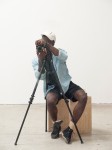Paul Mpagi Sepuya’s photos of cameras, mirrors and fragmented bodies will take over the walls of the Museum of Modern Art in New York.
The six photos are a part of MoMa’s “Being: New Photography 2018” exhibition, which opens Sunday and runs until Aug. 19. The exhibition assembles works of 17 photographers that express the concepts of personhood in relation to identity, community and psychology. Sepuya, a UCLA alumnus, said his work features photographic equipment and studio space as a means of examining the ways identity and individuality – of both the image-maker and the subject – manifest in the construction of an image.
“I am interested in how we let images, identity and subjectivity go into the construction of an image,” Sepuya said. “How central elements of photography break it apart and how it relates to ideas of gender, race, sexuality, community and friendship, and how all those come together.”
In “A sitting for Matthew (_R2A9192),” which was shot in 2015, a black drape swallows two-thirds of the composition. A sliver of space at the top reveals a collage-like compilation of a hand, a face, a lower body and a tripod leg.
Sepuya said the staging props in the photo – fabrics, mirrors and the camera equipment itself – are typically found in photography studios and reference the history of photography, from its beginnings in the early 19th century to modernist practices.
“(The elements) are tied to a point in time starting in the 1920s and ’30s with (the emergence of) a more self-acknowledged gaze in photography,” Sepuya said. “You put a drapery and a column and mirror, and it’s art instead of a naked person.”
More recent pieces, such as “Untitled,” a self-portrait of Sepuya sitting on the edge of a bench in the nude framed by a jet-black curtain, demonstrate this self-consciousness: The photographer is not a mere extension of their camera. Rather, their camera is an extension of themselves. The photo features Sepuya’s bare back turned to a smudged mirror in which viewers see the reflection of his body and a camera lens pointing out of the frame.
Although Sepuya’s face is obscured, he said the camera lens behaves as an extension of his eye, which looks out at the world with a queer, black gaze.
“There is blackness as frame, extension of my eye, and the drapery … that recurs across this entire body of work,” Sepuya wrote in his masters thesis published at UCLA.
Sepuya said his photographs draw much of their content from queer and homosexual social spaces, which allow him to reach a deeper understanding of how such communities come together and interact. Sepuya uses the process of photographing friends and lovers in the studio and rearranging the images as a self-reflexive exercise to situate his relationship to the subjects and their relationship to their larger social sphere, he said.
“They are formal works that are using content that comes from these fluid spaces between creatives, and the social and sexual exchange that are among artists and particularly queer social spaces,” he said.
Catherine Opie, professor of photography in the UCLA department of art and area head of the photography department, said Sepuya’s photographs are groundbreaking in their reconsideration of conventional portraiture and their presentation of Sepuya’s racial and sexual identities. Sepuya’s portrayal of the camera contraption, or photo apparatus, in his art helps draw focus to the construction of the images, Opie said.
“Mirror Study (4R2A0857),” 2016, uses the presence of photographic prints, a mirror, a camera apparatus and subjects to indicate the process of image-making, Sepuya said. The mirror reflects the triangular shape of a photographic print, revealing fragments of a subject’s legs and hand, and a partial view of the camera tripod. An arm emerges from the right of the frame, passing behind the print, while Sepuya’s arm reaches into the frame from the left and rests atop the mirror’s surface.
Opie said Sepuya’s methods of combining elements of body, identity and abstraction in photographs not only collapse a long history of portraiture, but also reinvent the language of self-portraiture.
Nikita Gale, a Los Angeles-based artist who shared a studio space with Sepuya in East LA during their MFA programs, said Sepuya’s rephotographing of pre-existing photographs creates layered content in a two-dimensional space.
“What you are looking at when you are looking at his work is actually over a decade of archival information that he is putting into the work,” Gale said. “He is documenting things and deconstructing them and then redocumenting them, so there is renewal that always happens in the work.”
Another work that iterates the archival process is “A ground (0083),” which references existing relationships and past times through the absence of a portrait, Sepuya said. Smudges on the mirror’s glass surface, left behind by a previous subject’s legs and arms, reference an already culminated event and allude to relationships that exist beyond the bounds of the photographic frame.
Like “A ground (0083),” none of Sepuya’s works are direct portraits. They ultimately use the visual language associated with portraiture to examine subjectivity on either side of the camera lens, he said.
“Portraiture is a starting point to acknowledging a direction in which looking and desire goes, but I am more interested in the material result of the complication in the production of portraiture,” Sepuya said.
